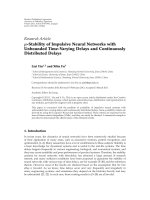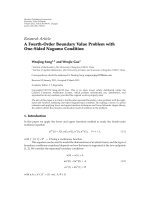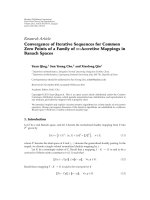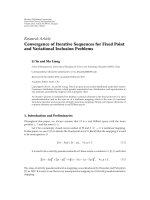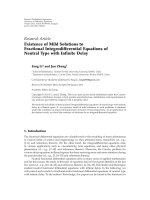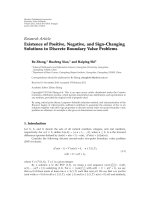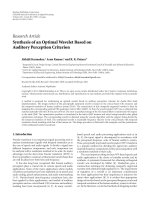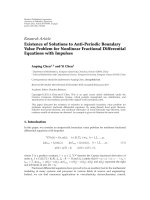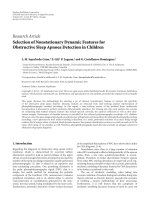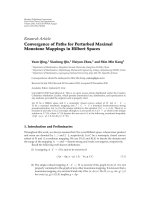Báo cáo hóa học: " Research Article Hierarchies of Difference Boundary Value Problems" pptx
Bạn đang xem bản rút gọn của tài liệu. Xem và tải ngay bản đầy đủ của tài liệu tại đây (709 KB, 27 trang )
Hindawi Publishing Corporation
Boundary Value Problems
Volume 2011, Article ID 743135, 27 pages
doi:10.1155/2011/743135
Research Article
Hierarchies of Difference Boundary Value Problems
Sonja Currie and Anne D. Love
School of Mathematics, University of the Witwatersrand, Private Bag 3, Wits 2050, South Africa
Correspondence should be addressed to Sonja Currie,
Received 25 November 2010; Accepted 11 January 2011
Academic Editor: Olimpio Miyagaki
Copyright q 2011 S. Currie and A. D. Love. This is an open access article distributed under
the Creative Commons Attribution License, which permits unrestricted use, distribution, and
reproduction in any medium, provided the original work is properly cited.
This paper generalises the work done in Currie and Love 2010, where we studied the effect of
applying two Crum-type transformations to a weighted second-order difference equation with
various combinations of Dirichlet, non-Dirichlet, and affine λ-dependent boundary conditions at
the end points, where λ is the eigenparameter. We now consider general λ-dependent boundary
conditions. In particular we show, using one of the Crum-type transformations, that it is possible
to go up and down a hierarchy of boundary value problems keeping the form of the second-
order difference equation constant but possibly increasing or decreasing the dependence on λ of
the boundary conditions at each step. In addition, we show that the transformed boundary value
problem either gains or loses an eigenvalue, or the number of eigenvalues remains the same as we
step up or down the hierarchy.
1. Introduction
Our interest in this topic arose from the work done on transformations and factorisations
of continuous Sturm-Liouville boundary value problems by Binding et al. 1 and Browne
and Nillsen 2, notably. We make use of analogous ideas to those discussed in 3–5 to
study difference equations in order to contribute to the development of the theory of discrete
spectral problems.
Numerous efforts to develop hierarchies exist in the literature, however, they are not
specifically aimed at difference equations per se and generally not for three-term recurrence
relations. Ding et al., 6, derived a hierarchy of nonlinear differential-difference equations
by starting with a two-parameter discrete spectral problem, as did Luo and Fan 7, whose
hierarchy possessed bi-Hamiltonian structures. Clarkson et al.’s, 8, interest in hierarchies
lay in the derivation of infinite sequences of systems of difference equations by using
the B¨acklund transformation for the equations in the second Painleve’ equation hierarchy.
Wu and Geng, 9, showed early on that the hierarchy of differential-difference equations
possesses Hamiltonian structures while a Darboux transformation for the discrete spectral
problem is shown to exist.
2 Boundary Value Problems
In this paper, we consider a weighted second-order difference equation of the form
c
n
y
n 1
− b
n
y
n
c
n − 1
y
n − 1
−c
n
λy
n
, 1.1
where cn > 0 represents a weight function and bn a potential function.
Our aim is to extend the results obtained in 10, 11 by establishing a hierarchy
of difference boundary value problems. A key tool in our analysis will be the Crum-type
transformation 2.1.In10, it was shown that 2.1 leaves the form of the difference
equation 1.1 unchanged. For us, the effect of 2.1 on the boundary conditions will be
crucial. We consider λ
eigenparameter-dependent boundary conditions at the end points. In
particular, the eigenparameter dependence at the initial end point will be given by a positive
Nevanlinna function, Nλ say, and at the terminal end point by a negative Nevanlinna
function, Mλ say. The case of NλMλ0 was covered in 10 and the the case of
NλMλconstant was studied in 11. Applying transformation 2.1 to the boundary
conditions results in a so-called transformed boundary value problem, where either the new
boundary conditions have more λ-dependence, less λ-dependence, or the same amount of
λ-dependence as the original boundary conditions. Consequently the transformed boundary
value problem has either one more eigenvalue, one less eigenvalue, or the same number of
eigenvalues as the original boundary value problem. Thus, it is possible to construct a chain,
or hierarchy, of difference boundary value problems where the successive links in the chain
are obtained by applying the variations of 2.1 given in this paper. For instance, it is possible
to go from a boundary value problem with λ-dependent boundary conditions to a boundary
value problem with λ-independent boundary conditions or vice versa simply by applying
the correct variation of 2.1 an appropriate number of times. Moreover, at each step, we can
precisely track the eigenvalues that have been lost or gained. Hence, this paper provides a
significant development in the theory of three-term difference boundary value problems in
regard to singularities and asymptotics in the hierarchy structure. For similar results in the
continuous case, see 12.
There is an obvious connection between the three-term difference equation and
orthogonal polynomials. In fact, the three-term recurrence relation satisfied by orthogonal
polynomials is perhaps the most important information for the constructive and computa-
tional use of orthogonal polynomials 13.
Difference equations and operators and results concerning their existence and
construction of their solutions have been discussed in 14,
15.Difference equations arise
in numerous settings and have applications in diverse areas such as quantum field theory,
combinatorics, mathematical physics and biology, dynamical systems, economics, statistics,
electrical circuit analysis, computer visualization, and many other fields. They are especially
useful where recursive computations are required. In particular see 169, Introduction
for three physical applications of the difference equation 1.1, namely, the vibrating string,
electrical network theory and Markov processes, in birth and death processes and random
walks.
It should be noted that G. Teschl’s work, 17, Chapter 11, on spectral and inverse
spectral theory of Jacobi operators, provides an alternative factorisation, to that of 10,ofa
second-order difference equation, where the factors are adjoints of one another.
This paper is structured as follows.
In Section 2, all the necsessary results from 10 are recalled, in particular how 1.1
transforms under 2.1. In addition, we also recap some important properties of Nevanlinna
functions.
Boundary Value Problems 3
The focus of Section 3 is to show exactly the effect that 2.1 has on boundary
conditions of the form
y
−1
N
λ
y
0
,y
m − 1
M
λ
y
m
. 1.2
We give explicitly the new boundary conditions which are obeyed, from which it can be seen
whether the λ-dependence has increased, decreased, or remained the same.
Lastly, in Section 4, we compare the spectrum of the original boundary value problem
with that of the transformed boundary value problem and show under which conditions the
transformed boundary value problem has one more eigenvalue, one less eigenvalue, or the
same number of eigenvalues as the original boundary value problem.
2. Preliminaries
In 10, we considered 1.1 for n 0, ,m−1, where the values of y−1 and ym are given
by boundary conditions, that is, yn is defined for n −1, ,m.
Let the mapping y → w be defined by
w
n
: y
n
− y
n − 1
z
n
z
n − 1
,n 0, ,m,
2.1
where, throughout this paper, zn is a solution to 1.1 for λ λ
0
such that zn > 0for
all n −1, ,m. Whether or not zn obeys the various given boundary conditions to be
specified later is of vital importance in obtaining the results that follow.
From 10, we have the following theorem.
Theorem 2.1. Under the mapping 2.1, 1.1 transforms to
c
w
n
w
n 1
− b
w
n
w
n
c
w
n − 1
w
n − 1
−λc
w
n
w
n
, 2.2
where for n 0, ,m
c
w
n
c
n − 1
z
n − 1
z
n
,
b
w
n
c
n − 1
z
n − 1
c
n
z
n
z
n
z
n − 1
c
n − 1
z
n − 1
z
n
.
2.3
We now recall some properties of Nevanlinna functions.
I The inverse of a positive Nevanlinna function is a negative Nevanlinna function,
that is
1
N
λ
−B
λ
,
2.4
where Nλ,Bλ are positive Nevanlinna functions. This follows directly from the fact that
Iz ≥ 0 if and only if I−1/z ≥ 0.
4 Boundary Value Problems
II If
N
λ
b −
s
j1
c
j
λ − d
j
,c
j
> 0,b
/
0,
2.5
then
1
N
λ
β −
s
j1
σ
j
λ − δ
j
,σ
j
> 0,β
/
0.
2.6
This follows by I together with the fact that since Nλ has s zeros 1/Nλ has s poles. Also
Nλ → b as λ →±∞so 1/Nλ → 1/b : β as λ →±∞.Thus,ifNλ is a positive
Nevanlinna function of the form 2.5, then for b
/
0, 1/Nλ is a negative Nevanlinna
function of the same form.
III If
N
λ
aλ b −
s
j1
c
j
λ − d
j
,a
j
,c
j
> 0,
2.7
then
1
N
λ
−
s1
j1
σ
j
λ − δ
j
,σ
j
> 0,
2.8
since Nλ has s 1zerosso1/Nλ has s 1 poles and Nλ → aλ b →±∞as λ →±∞
so 1/Nλ → 1/aλ b → 0asλ →±∞.
For the remainder of the paper, N
s,j
λ will denote a Nevanlinna function where
s is the number of terms in the sum;
j indicates the value of n at which the boundary condition is imposed and
⎧
⎨
⎩
± if the coefficient of λ is positive or negative respectively,
0 if the coefficient of λ is zero.
2.9
3. General λ-Dependent Boundary Conditions
In this section, we show how y obeying general λ-dependent boundary conditions
transforms, under 2.1,tow obeying various types of λ-dependent boundary conditions.
The exact form of these boundary conditions is obtained by considering the number of zeros
and poles singularities of the various Nevanlinna functions under discussion and these
correlations are illustrated in the different graphs depicted in this section.
Boundary Value Problems 5
Lemma 3.1. If y obeys the boundary condition
y
−1
b −
s
k1
c
k
λ − d
k
y
0
: R
0
s,−1
λ
y
0
,
3.1
then the domain of wn may be extended from n 0, ,mto n −1, ,mby forcing the condition
w
−1
w
0
U,
3.2
where
U
b
w
0
− λc
w
0
c
w
−1
−
c
w
0
c
w
−1
b
0
/c
0
− λ − z
1
/z
0
−
c
−1
/c
0
R
0
s,−1
λ
1 − R
0
s,−1
λ
z
0
/z
−1
3.3
with c
w
−1c−1.
Proof. The transformed equation 2.2,forn 0, together with 3.2 gives
c
w
0
w
1
c
w
−1
Uw
0
b
w
0
− λc
w
0
w
0
. 3.4
Also the mapping 2.1, together with 3.1, yields
w
0
y
0
1 − R
0
s,−1
λ
z
0
z
−1
.
3.5
Substituting 3.5 into 3.4,weobtain
c
w
0
w
1
c
w
−1
U
1 − R
0
s,−1
λ
z
0
z
−1
y
0
b
w
0
− λc
w
0
1 − R
0
s,−1
λ
z
0
z
−1
y
0
.
3.6
Now 2.1,withn 1, gives
w
1
y
1
− y
0
z
1
z
0
3.7
which when substituted into 3.6 and dividing through by c
w
0 results in
y
1
− y
0
z
1
z
0
c
w
−1
c
w
0
U
1 − R
0
s,−1
λ
z
0
z
−1
y
0
b
w
0
c
w
0
− λ
1 − R
0
s,−1
λ
z
0
z
−1
y
0
.
3.8
6 Boundary Value Problems
This may be rewritten as
y
1
− y
0
z
1
z
0
−
c
w
−1
c
w
0
U −
b
w
0
c
w
0
1 − R
0
s,−1
λ
z
0
z
−1
−λ
1 − R
0
s,−1
λ
z
0
z
−1
y
0
.
3.9
Using 1.1,withn 0, together with 3.1,gives
y
1
−
b
0
c
0
−
c
−1
c
0
R
0
s,−1
λ
y
0
−λy
0
.
3.10
Subtracting 3.10 from 3.9 results in
y
0
b
0
c
0
−
c
−1
c
0
R
0
s,−1
λ
−
z
1
z
0
c
w
−1
c
w
0
U −
b
w
0
c
w
0
1 − R
0
s,−1
λ
z
0
z
−1
y
0
−λ
1 − R
0
s,−1
λ
z
0
z
−1
λ
.
3.11
Rearranging the above equation and dividing through by 1−R
0
s,−1
λz0/z−1c
w
−1/
c
w
0 yields
c
w
0
/c
w
−1
b
0
/c
0
−
c
−1
/c
0
R
0
s,−1
λ
− z
1
/z
0
− λ
1 − R
0
s,−1
λ
z
0
/z
−1
U −
b
w
0
c
w
−1
−λ
c
w
0
c
w
−1
3.12
and hence
U
b
w
0
− λc
w
0
c
w
−1
−
c
w
0
c
w
−1
b
0
/c
0
− λ − z
1
/z
0
−
c
−1
/c
0
R
0
s,−1
λ
1 − R
0
s,−1
λ
z
0
/z
−1
. 3.13
Thus w obeys the equation on the extended domain.
The remainder of this section illustrates why it is so important to distinguish between
the two cases of z obeying or not obeying the boundary conditions.
Boundary Value Problems 7
Theorem 3.2. Consider yn obeying the boundary condition 3.1 where R
0
s,−1
λ is a positive
Nevanlinna function, that is, c
k
> 0 for k 1, ,s. Under the mapping 2.1, y obeying 3.1
transforms to w obeying 3.2 as follows.
A If z does not obey 3.1 then w obeys
i
w
−1
Uw
0
β −
s
t1
γ
t
λ − q
t
w
0
: T
0
s,−1
λ
w
0
,b 0,
3.14
ii
w
−1
Uw
0
αλ β −
s
t1
γ
t
λ − q
t
w
0
: T
s,−1
λ
w
0
,
z
−1
z
0
>b>0.
3.15
B If z does obey 3.1 for λ λ
0
then w obeys
i
w
−1
Uw
0
β −
s−1
t1
γ
t
λ − v
t
w
0
:
T
0
s−1,−1
λ
w
0
,b 0,
3.16
ii
w
−1
Uw
0
αλ
β −
s−1
t1
γ
t
λ − v
t
w
0
:
T
s−1,−1
λ
w
0
,
z
−1
z
0
>b>0,
3.17
where γ
t
, γ
t
,α,α>0, that is, T
0
s,−1
λ,T
s,−1
λ,
T
0
s−1,−1
λ,
T
s−1,−1
λ are positive
Nevanlinna functions.
In (A) and (B), b<0 is not possible.
8 Boundary Value Problems
Proof. The fact that w−1Uw0 is by construction, see Lemma 3.1. We now examine the
form of U in Lemma 3.1.LetΓ
1
: b
w
0/c
w
−1, Γ
2
: c
w
0/c
w
−1, Γ
3
: b0/c0 −
z1/z0 and Γ
4
: c−1/c0 then
w
−1
w
0
U Γ
1
− λΓ
2
− Γ
2
Γ
3
− λ − Γ
4
R
0
s,−1
λ
1 −
z
0
/z
−1
R
0
s,−1
λ
Γ
1
− λΓ
2
− Γ
2
Γ
4
z
−1
z
0
Γ
3
− λ − Γ
4
z
−1
/z
0
1 −
z
0
/z
−1
R
0
s,−1
λ
Γ
1
− λΓ
2
− Γ
2
Γ
4
z
−1
z
0
Γ
2
z
−1
/z
0
λ − Γ
3
Γ
4
z
−1
/z
0
z
−1
/z
0
− R
0
s,−1
λ
.
3.18
But
Γ
3
− Γ
4
z
−1
z
0
b
0
c
0
−
z
1
z
0
−
c
−1
c
0
λ
0
3.19
thus
w
−1
w
0
U Γ
1
− λΓ
2
− Γ
2
Γ
4
z
−1
z
0
Γ
2
z
−1
/z
0
λ − λ
0
z
−1
/z
0
− R
0
s,−1
λ
.
3.20
Now λ − λ
0
/z−1/z0 − R
0
s,−1
λ has the expansion
f
λ
−
p
t1
r
t
λ − q
t
,
3.21
where r
t
> 0andtheq
t
’s correspond to where z−1/z0R
0
s,−1
λ, that is, the singularities
of 3.20.
Since R
0
s,−1
λ is a positive Nevanlinna function it has a graph of the form shown in
Figure 1.
Clearly, the gradient of R
0
s,−1
λ at q
t
is positive for all t,thatis,
∂
∂λ
R
0
s,−1
λ
q
t
> 0,t 1, ,p.
3.22
Boundary Value Problems 9
R
0
s,−1
λ
z−1
z0
b
q
1
q
2
q
3
d
1
d
2
d
3
λ
Figure 1: R
0
s,−1
λ.
If z does not obey 3.1, then the zeros of
λ − λ
0
z
−1
/z
0
− R
0
s,−1
λ
3.23
are the poles of R
0
s,−1
λ,thatis,thed
k
’s and λ λ
0
where d
k
/
λ
0
for k 1, ,s. It is evident,
from Figure 1, that the number of q
t
’s is equal to the number of d
k
’s, thus in 3.21, p s.
We now examine the form of fλ in 3.21.Asλ →±∞it follows that R
0
s,−1
λ → b.
Thus
λ − λ
0
z
−1
/z
0
− R
0
s,−1
λ
−→
λ − λ
0
z
−1
/z
0
− b
.
3.24
Therefore
f
λ
λ − λ
0
z
−1
/z
0
− b
.
3.25
Hence, substituting into 3.20 gives
w
−1
w
0
U Γ
1
− λΓ
2
− Γ
2
Γ
4
z
−1
z
0
Γ
2
z
−1
z
0
f
λ
−
s
t1
r
t
λ − q
t
Γ
1
− λΓ
2
− Γ
2
Γ
4
z
−1
z
0
Γ
2
z
−1
z
0
λ − λ
0
z
−1
/z
0
− b
−
s
t1
r
t
λ − q
t
Γ
1
− Γ
2
Γ
4
z
−1
z
0
−
λ
0
Γ
2
1 − b
z
0
/z
−1
λ
−Γ
2
Γ
2
1 − b
z
0
/z
−1
− Γ
2
z
−1
z
0
s
t1
r
t
λ − q
t
.
3.26
10 Boundary Value Problems
Let
β :Γ
1
− Γ
2
Γ
4
z
−1
z
0
−
λ
0
Γ
2
1 − b
z
0
/z
−1
,
α : −Γ
2
Γ
2
1 − b
z
0
/z
−1
Γ
2
b
z
−1
/z
0
− b
,
γ
t
:Γ
2
z
−1
z
0
r
t
.
3.27
Then since Γ
2
> 0, z−1/z0 > 0andr
t
> 0 we have that γ
t
> 0 and clearly if b 0 then α 0
giving 3.14,thatis,
w
−1
Uw
0
β −
s
t1
γ
t
λ − q
t
w
0
: T
0
s,−1
λ
w
0
.
3.28
If b
/
0 then we want α>0 so that we have a positive Nevanlinna function, that is
Γ
2
b
z
−1
/z
0
− b
> 0
3.29
which means that either,
Γ
2
b>0,
z
−1
z
0
− b>0,
3.30
giving that, since Γ
2
> 0,
b>0,
z
−1
z
0
>b,
3.31
which is as shown in Figure 1,or,
Γ
2
b<0,
z
−1
z
0
− b<0,
3.32
giving that
b<0,
z
−1
z
0
<b,
3.33
but this means that z−1/z0 < 0 which is not possible.
Boundary Value Problems 11
Thus, α>0forz−1/z0 >b>0, that is, given b, the ratio z−1/z0 must be chosen
suitably to ensure that T
s,−1
λ is a positive Nevanlinna function as required. Hence we obtain
3.15,thatis
w
−1
Uw
0
αλ β −
s
t1
γ
t
λ − q
t
w
0
: T
s,−1
λ
w
0
.
3.34
If z obeys 3.1,forλ λ
0
, then z−1/z0R
0
s,−1
λ
0
.ThusinFigure 1,oneoftheq
t
’s
t 1, ,sis equal to λ
0
and since λ
0
is less than the least eigenvalue of the boundary value
problem 1.1, 3.1 together with a boundary condition at m − 1 specified later it follows
that q
1
λ
0
,asλ
0
<d
k
for all k 1, ,s.
Now
λ − λ
0
z
−1
/z
0
− R
0
s,−1
λ
λ − λ
0
R
0
s,−1
λ
0
− R
0
s,−1
λ
1
R
0
s,−1
λ
0
− R
0
s,−1
λ
/
λ − λ
0
3.35
and as λ → λ
0
1
R
0
s,−1
λ
0
− R
0
s,−1
λ
/
λ − λ
0
−→ −
∂
∂λ
R
0
s,−1
λ
λ
0
< 0.
3.36
Thus λ λ
0
q
1
is a removable singularity. Alternatively,
λ − λ
0
R
0
s,−1
λ
0
− R
0
s,−1
λ
λ − λ
0
b −
s
k1
c
k
/
λ
0
− d
k
− b
s
k1
c
k
/
λ − d
k
−1
s
k1
c
k
/
λ
0
− d
k
λ − d
k
,
3.37
which illustrates that the singularity at λ λ
0
q
1
is removable.
We now have that the number of nonremovable singularities, q
t
,in3.20 is one less
than the number of d
k
’s k 1, ,s,seeFigure 1.Thus3.21 becomes
f
λ
−
s
t2
r
t
λ − q
t
,r
t
> 0
3.38
which may be rewritten as
f
λ
−
s−1
t1
r
t
λ − v
t
, r
t
> 0,
3.39
where v
n
q
n1
, r
n
r
n1
for n 1, ,s− 1.
12 Boundary Value Problems
We now examine the form of fλ in 3.39.Asλ →±∞, we have that, as before,
R
0
s,−1
λ → b.Thus
f
λ
λ − λ
0
R
0
s,−1
λ
0
− b
.
3.40
Hence, from 3.20,
w
−1
w
0
U Γ
1
− λΓ
2
− Γ
2
Γ
4
R
0
s,−1
λ
0
Γ
2
R
0
s,−1
λ
0
f
λ
−
s−1
t1
r
t
λ − v
t
Γ
1
− λΓ
2
− Γ
2
Γ
4
R
0
s,−1
λ
0
Γ
2
R
0
s,−1
λ
0
λ − λ
0
R
0
s,−1
λ
0
− b
−
s−1
t1
r
t
λ − v
t
Γ
1
− Γ
2
Γ
4
R
0
s,−1
λ
0
−
λ
0
Γ
2
1 − b
1/R
0
s,−1
λ
0
λ
⎡
⎢
⎣
−Γ
2
Γ
2
1 − b
1/R
0
s,−1
λ
0
⎤
⎥
⎦
− Γ
2
R
0
s,−1
λ
0
s−1
t1
r
t
λ − v
t
.
3.41
Let
β :Γ
1
− Γ
2
Γ
4
R
0
s,−1
λ
0
−
λ
0
Γ
2
1 − b
1/R
0
s,−1
λ
0
,
α : −Γ
2
Γ
2
1 − b
1/R
0
s,−1
λ
0
Γ
2
b
R
0
s,−1
λ
0
− b
,
γ
t
:Γ
2
R
0
s,−1
λ
0
r
t
.
3.42
Then since Γ
2
> 0, R
0
s,−1
λ
0
> 0andr
t
> 0 we have that γ
t
> 0 and clearly if b 0 then α 0
giving 3.16,thatis,
w
−1
Uw
0
β −
s−1
t1
γ
t
λ − v
t
w
0
:
T
0
s−1,−1
λ
w
0
.
3.43
If b
/
0 then we need α>0 so that we have a positive Nevanlinna function, that is
Γ
2
b
R
0
s,−1
λ
0
− b
> 0
3.44
Boundary Value Problems 13
which means that either
Γ
2
b>0,R
0
s,−1
λ
0
− b>0,
3.45
giving that, since Γ
2
> 0,
b>0,R
0
s,−1
λ
0
z
−1
z
0
>b,
3.46
which is as shown in Figure 1,or,
Γ
2
b<0,R
0
s,−1
λ
0
− b<0,
3.47
giving that
b<0,R
0
s,−1
λ
0
<b,
3.48
but this means that R
0
s,−1
λ
0
z−1/z0 < 0 which is not possible.
Thus, α>0forR
0
s,−1
λ
0
>b>0, that is, given b, the ratio z−1/z0R
0
s,−1
λ
0
must
be chosen suitably to ensure that
T
s−1,−1
λ is a positive Nevanlinna function as required.
Hence, we obtain 3.17,thatis,
w
−1
Uw
0
αλ
β −
s−1
t1
γ
t
λ − v
t
w
0
:
T
s−1,−1
λ
w
0
.
3.49
In the theorem below, we increase the λ dependence by introducing a nonzero λ term
in the original boundary condition. As in Theorem 3.2,theλ dependence of the transformed
boundary condition depends on whether or not z obeys the given boundary condition. In
addition, to ensure that the λ dependence of the transformed boundary condition is given
by a positive Nevanlinna function it is necessary that the transformed boundary condition
is imposed at 0 and 1 as opposed to −1 and 0. Thus the interval under consideration shrinks
by one unit at the initial end point. By routine calculation it can be shown that the form of
the λ dependence of the transformed boundary condition, if imposed at −1 and 0, is neither a
positive Nevalinna function nor a negative Nevanlinna function.
Theorem 3.3. Consider yn obeying the boundary condition
y
−1
aλ b −
s
k1
c
k
λ − d
k
y
0
: R
s,−1
λ
y
0
,
3.50
where R
s,−1
λ is a positive Nevanlinna function, that is, a>0 and c
k
> 0 for k 1, ,s. Under the
mapping 2.1, y obeying 3.50 transforms to w obeying the following.
14 Boundary Value Problems
1 If z does not obey 3.50 then w obeys
w
0
β
−
s1
t1
γ
t
λ −
δ
t
w
1
:
T
0
s1,0
λ
w
1
.
3.51
2 If z does obey 3.50,forλ λ
0
,thenw obeys
w
0
β −
s
t1
γ
t
λ − δ
t
w
1
:
T
0
s,0
λ
w
1
,
3.52
where γ
t
, γ
t
> 0.
Proof. Since w0 and w1 are defined we do not need to extend the domain in order to
impose the boundary conditions 3.51 or 3.52.
The mapping 2.1,atn 0, together with 3.50 gives
w
0
y
0
1 − R
s,−1
λ
z
0
z
−1
.
3.53
Also 2.1,atn 1, is
w
1
y
1
− y
0
z
1
z
0
.
3.54
Substituting in for y1 from 1.1,withn 1, and using 3.50,weobtainthat
w
1
y
0
b
0
c
0
−
z
1
z
0
− λ −
c
−1
c
0
R
s,−1
λ
.
3.55
From 3.53 and 3.55, it now follows that
w
0
w
1
1 − R
s,−1
λ
z
0
/z
−1
b
0
/c
0
− z
1
/z
0
− λ −
c
−1
/c
0
R
s,−1
λ
.
3.56
As in Theorem 3.2,letΓ
3
b0/c0 − z1/z0 and Γ
4
c−1/c0. Then 3.56 becomes
w
0
w
1
1 − R
s,−1
λ
z
0
/z
−1
Γ
3
− λ − Γ
4
R
s,−1
λ
z
0
/z
−1
Γ
3
− λ − Γ
4
R
s,−1
λ
/
z
−1
/z
0
− R
s,−1
λ
z
0
/z
−1
Γ
4
−
−Γ
3
λ Γ
4
z
−1
/z
0
/
z
−1
/z
0
− R
s,−1
λ
.
3.57
Boundary Value Problems 15
R
s,−1
λ
z−1
z0
q
1
q
2
q
3
q
4
d
1
d
2
d
3
aλ b
λ
Figure 2: R
s,−1
λ.
From Theorem 3.2, we have that Γ
3
− Γ
4
z−1/z0 λ
0
so
w
0
w
1
z
0
z
−1
⎡
⎢
⎣
1
Γ
4
−
λ − λ
0
/
z
−1
/z
0
− R
s,−1
λ
⎤
⎥
⎦
. 3.58
Also, as in Theorem 3.2,
λ − λ
0
z
−1
/z
0
− R
s,−1
λ
,
3.59
has the expansion
f
λ
−
p
t1
r
t
λ − q
t
, r
t
> 0,
3.60
where q
t
corresponds to z−1/z0R
s,−1
λ, that is, the singularities of 3.59.NowR
s,−1
λ
is a positive Nevanlinna function with graph given in Figure 2.
Clearly, the gradient of R
s,−1
λ at qt is positive for all t 1, ,p,thatis,
∂
∂λ
R
s,−1
λ
q
t
> 0,t 1, ,p.
3.61
16 Boundary Value Problems
If z does not obey 3.50 then the zeros of
λ − λ
0
z
−1
/z
0
− R
s,−1
λ
3.62
are the poles of R
s,−1
λ,thatis,thed
k
’s and λ λ
0
where d
k
/
λ
0
for k 1, ,s. It is evident,
from Figure 2, that the number of q
t
’s is one more than the number of d
k
’s, thus in 3.60,
p s 1.
We now examine the form of
fλ in 3.60.Asλ →±∞it follows that R
s,−1
λ →
aλ b,thus
λ − λ
0
z
−1
/z
0
− R
s,−1
λ
−→
λ − λ
0
z
−1
/z
0
−
aλ b
−→ −
1
a
.
3.63
Hence,
fλ−1/a.
Using 3.58 we now obtain
w
0
w
1
z
0
z
−1
⎡
⎢
⎣
1
Γ
4
−
f
λ
−
s1
t1
r
t
/
λ − q
t
⎤
⎥
⎦
z
0
z
−1
1
Γ
4
1/a
s1
t1
r
t
/
λ − q
t
1
z
−1
/z
0
Γ
4
z
−1
/z
0
1/a
s1
t1
r
t
z
−1
/z
0
/
λ − q
t
.
3.64
Note that r
t
z−1/z0 > 0. Let
Δ :
z
−1
z
0
Γ
4
z
−1
z
0
1
a
,
3.65
then
w
0
w
1
1
Δ −
s1
t1
−r
t
z
−1
/z
0
/
λ − q
t
.
3.66
Boundary Value Problems 17
Now Δ
/
0 since if Δ0 then Γ−1/a,thatis,c0/c−1−a but a>0andc0/c−1 > 0
so this is not possible. Therefore by Section 2, Nevanlinna result II, we have that
w
0
β −
s1
t1
γ
t
λ −
δ
t
w
1
:
T
0
s1,0
λ
w
1
,
3.67
that is, 3.51 holds.
If z does obey 3.50 for λ λ
0
then z−1/z0R
s,−1
λ
0
.Thus,inFigure 2,oneof
the q
t
’s, t 1, ,pis equal to λ
0
and since λ
0
is less than the least eigenvalue of the boundary
value problem 1.1, 3.50 together with a boundary condition at m − 1 specified later it
follows that q
1
λ
0
,asλ
0
<d
k
for all k 1, ,s.
Now 3.59 can be written as
λ − λ
0
R
s,−1
λ
0
− R
s,−1
λ
1
R
s,−1
λ
0
− R
s,−1
λ
/
λ − λ
0
3.68
and as λ → λ
0
1
R
s,−1
λ
0
− R
s,−1
λ
/
λ − λ
0
−→ −
∂
∂λ
R
s,−1
λ
λ
0
< 0.
3.69
Thus λ λ
0
q
1
is a removable singularity. Alternatively, we could substitute in for R
s,−1
λ
and R
s,−1
λ
0
to illustrate that the singularity at λ λ
0
q
1
is removable, see Theorem 3.2.
Hence the number of nonremovable q
t
’s is the same as the number of d
k
’s, see Figure 2.So
3.60 becomes
f
λ
−
s1
t2
r
t
λ − q
t
, r
t
> 0,
3.70
which may be rewritten as
f
λ
−
s
t1
r
t
λ − q
t
, r
t
> 0,
3.71
where
r
n
r
n1
and q
n
q
n1
for n 1, ,s.
We now examine the form of
fλ in 3.70.Asλ →±∞, we have that R
s,−1
λ →
aλ b,thus
λ − λ
0
R
s,−1
λ
0
− R
s,−1
λ
−→
λ − λ
0
R
s,−1
λ
0
−
aλ b
−→ −
1
a
.
3.72
18 Boundary Value Problems
Hence,
fλ−1/a. So, from 3.58 with z−1/z0R
s,−1
λ
0
,weobtain
w
0
w
1
1
R
s,−1
λ
0
Γ
4
1/a
s
t1
r
t
/
λ − q
t
1
Δ −
s
t1
−
r
t
R
s,−1
λ
0
/
λ −
q
t
,
3.73
where, as before,
Δ :
z
−1
z
0
Γ
4
z
−1
z
0
1
a
R
s,−1
λ
0
Γ
4
R
s,−1
λ
0
1
a
/
0.
3.74
Thus, by Section 2, Nevanlinna result II, we have that
w
0
β −
s
t1
γ
t
λ − δ
t
w
1
:
T
0
s,0
λ
w
1
,
γ
t
> 0,
3.75
that is, 3.52 holds.
In Theorem 3.4, we impose a boundary condition at the terminal end point and show
how it is transformed according to whether or not z obeys the given boundary condition.
Theorem 3.4. Consider y obeying the boundary condition at n m given by
y
m − 1
y
m
gλ h −
l
k1
s
k
λ − p
k
: y
m
R
−
l,m
λ
,
3.76
where R
−
l,m
λ is a negative Nevanlinna function, that is, g<0 and s
k
< 0 for k 1, ,l. Under the
mapping 2.1, y obeying 3.76 transforms to w obeying the following.
I If z does not obey 3.76 then w obeys
w
m − 1
w
m
φλ ϕ −
l1
t1
t
λ − σ
t
: w
m
T
−
l1,m
λ
.
3.77
II If z does obey 3.76 then w obeys
w
m − 1
w
m
φλ ϕ −
l
t1
t
λ − σ
t
: w
m
T
−
l,m
λ
,
3.78
where φ,
φ,
k
,
k
< 0.
Boundary Value Problems 19
Proof. Since wm − 1 and wm are defined we do not need to extend the domain of w in
order to impose the boundary conditions 3.77 or 3.78.
The mapping 2.1,atn m − 1, gives
w
m − 1
y
m − 1
− y
m − 2
z
m − 1
z
m − 2
.
3.79
From 1.1,withn m − 1, we can substitute in for ym − 2 in the above equation to get
w
m − 1
y
m − 1
1 λ
z
m − 1
c
m − 1
z
m − 2
c
m − 2
−
z
m − 1
b
m − 1
z
m − 2
c
m − 2
z
m − 1
c
m − 1
z
m − 2
c
m − 2
y
m
.
3.80
Using 3.76,weobtain
w
m − 1
y
m
R
−
l,m
λ
1 λ
z
m − 1
c
m − 1
z
m − 2
c
m − 2
−
z
m − 1
b
m − 1
z
m − 2
c
m − 2
z
m − 1
c
m − 1
z
m − 2
c
m − 2
.
3.81
But z obeys 1.1 at n m − 1, for λ λ
0
,sothat3.81 becomes
w
m − 1
y
m
z
m − 1
c
m − 1
z
m − 2
c
m − 2
R
−
l,m
λ
λ − λ
0
− R
−
l,m
λ
z
m
z
m − 1
1
.
3.82
Also, for n m, 2.1 together with 3.76 yields
w
m
y
m
1 − R
−
l,m
λ
z
m
z
m − 1
.
3.83
Therefore,
w
m − 1
w
m
z
m − 1
c
m − 1
z
m − 2
c
m − 2
λ − λ
0
R
−
l,m
λ
1 − R
−
l,m
λ
z
m
/z
m − 1
1
. 3.84
Let Ω :zm − 1cm − 1/zm − 2cm − 2 > 0, then 3.84 may be rewritten as
w
m − 1
w
m
Ω− Ω
λ − λ
0
z
m
/z
m − 1
− 1/R
−
l,m
λ
.
3.85
20 Boundary Value Problems
1
R
−
l,m
λ
zm
zm − 1
q
1
q
2
q
3
p
1
p
2
p
3
λ
Figure 3: 1/R
−
l,m
λ.
By Section 2, Nevanlinna result I,sinceR
−
l,m
λ is a negative Nevanlinna function it follows
that 1/R
−
l,m
λ is a positive Nevanlinna function, which has the form
1
R
−
l,m
λ
−
l1
k1
s
k
λ − p
k
, s
k
> 0,
3.86
by Section 2, Nevanlinna result III.
As before λ −λ
0
/zm/zm − 1 − 1/R
−
l,m
λ has expansion
f
λ
−
p
t1
r
t
λ − q
t
, r
t
> 0,
3.87
where
q
t
, t 1, ,p, corresponds to the singularities of 3.85, that is, where zm−1/zm
R
−
l,m
λ. The graph of 1/R
−
l,m
λ is as shown in Figure 3.
As before, the gradient of 1/R
−
l,m
λ at qt is positive for all t 1, ,p,thatis
∂
∂λ
1
R
−
l,m
λ
q
t
> 0,t 1, ,p.
3.88
If z does not obey 3.76 then the zeros of
λ − λ
0
z
m
/z
m − 1
− 1/R
−
l,m
λ
3.89
are the poles of 1/R
−
l,m
λ,thatis,thep
k
’s and λ λ
0
where p
k
/
λ
0
for k 1, ,l 1.
Clearly, from Figure 3, the number of
q
t
’s is the same as the the number of p
k
’s, thus in 3.87,
p l 1.
Boundary Value Problems 21
Next, we examine the form of
fλ in 3.87.Asλ →±∞it follows that 1/R
−
l,m
λ →
1/gλ h → 0. Thus
λ − λ
0
z
m
/z
m − 1
− 1/R
−
l,m
λ
−→
λ − λ
0
z
m − 1
z
m
.
3.90
Therefore,
fλλ − λ
0
zm − 1/zm. Hence,
w
m − 1
w
m
Ω− Ω
f
λ
−
l1
t1
r
t
λ − q
t
Ω− Ω
λ − λ
0
z
m − 1
z
m
−
l1
t1
r
t
λ − q
t
φλ ϕ −
l1
t1
t
λ − σ
t
: T
−
l1,m
λ
,
3.91
where ϕ :ΩΩzm − 1/zmλ
0
, φ : −Ωzm − 1/zm < 0,
t
: −Ωr
t
< 0andσ
t
: q
t
for t 1, ,l 1, which is precisely 3.77.
If z does obey 3.76 for λ λ
0
then zm −1/zmR
−
l,m
λ
0
.ThusinFigure 3,oneof
the
q
t
’s, t 1, ,pis equal to λ
0
and since λ
0
is less than the least eigenvalue of the boundary
value problem 1.1, 3.76 together with a boundary condition at −1 as given in Theorems
3.2 or 3.3 it follows that
q
1
λ
0
,asλ
0
< p
k
for all k 1, ,l 1.
Now
λ − λ
0
z
m
/z
m − 1
− 1/R
−
l,m
λ
λ − λ
0
1/R
−
l,m
λ
0
− 1/R
−
l,m
λ
R
−
l,m
λ
0
R
−
l,m
λ
R
−
l,m
λ
− R
−
l,m
λ
0
/
λ − λ
0
3.92
and as λ → λ
0
R
−
l,m
λ
0
R
−
l,m
λ
R
−
l,m
λ
− R
−
l,m
λ
0
/
λ − λ
0
−→
R
−
l,m
λ
0
2
∂/∂λ
R
−
l,m
λ
λ
0
> 0.
3.93
Thus λ λ
0
q
1
is a removable singularity. Again, alternatively, we could have substituted
in for R
−
l,m
λ and R
−
l,m
λ
0
to illustrate that the singularity at λ λ
0
q
1
is removable, see
Theorem 3.2. Hence the number of nonremovable
q
t
’s is one less than the number of p
k
’s, see
Figure 3.
22 Boundary Value Problems
So 3.87 becomes
f
λ
−
l1
t2
r
t
λ − q
t
, r
t
> 0,
3.94
which may be rewritten as
f
λ
−
l
t1
r
t
λ − q
t
,r
t
> 0,
3.95
where r
n
r
n1
and q
n
q
n1
for n 1, ,l.
Now as λ →±∞,
λ − λ
0
1/R
−
l,m
λ
0
− 1/R
−
l,m
λ
−→ R
−
l,m
λ
0
λ − λ
0
.
3.96
So, we obtain
w
m − 1
w
m
Ω− Ω
f
λ
−
l
t1
r
t
λ − q
t
Ω− Ω
λ − λ
0
R
−
l,m
λ
0
−
l
t1
r
t
λ − q
t
φλ ϕ −
l
t1
t
λ − σ
t
:
T
−
l,m
λ
,
3.97
where ϕ :ΩΩλ
0
R
−
l,m
λ
0
,
φ : −ΩR
−
l,m
λ
0
< 0,
t
: −Ωr
t
< 0, and σ
t
: q
t
for all t 1, ,l,
that is, we obtain 3.78.
4. Comparison of the Spectra
In this section, we investigate how the spectrum of the original boundary value problem
compares to the spectrum of the transformed boundary value problem. This is done by
considering the degree of the eigenparameter polynomial for the various eigenconditions.
Boundary Value Problems 23
Lemma 4.1. Consider the boundary value problem given by 1.1 for n 0, ,r − 1 together with
boundary conditions
y
−1
aλ b −
s
k1
c
k
λ − d
k
y
0
,a>0,c
k
> 0,
4.1
y
r − 1
⎡
⎣
αλ β −
p
j1
γ
j
λ − σ
j
⎤
⎦
y
r
,α<0,γ
j
< 0. 4.2
Then the boundary value problem 1.1, 4.1, 4.2 has spr 1 eigenvalues. (Note that the number
of unit intervals considered is r 1.)
Proof. From 1.1,withn 0, we obtain
y
1
−
c
−1
y
−1
c
0
b
0
c
0
− λ
y
0
.
4.3
Substituting in for y−1 from 4.1 yields
y
1
−
c
−1
c
0
aλ b −
s
k1
c
k
λ − d
k
b
0
c
0
− λ
y
0
,
4.4
which may be rewritten as
y
1
:
P
1
0
P
1
1
λ ··· P
1
s1
λ
s1
λ − d
1
λ − d
2
···
λ − d
s
y
0
,
4.5
where P
1
i
, i 0, ,s 1 are real constants.
Now 1.1,forn 1, together with 4.5 results in
y
2
−
c
0
c
1
b
1
c
1
− λ
P
1
0
P
1
1
λ ··· P
1
s1
λ
s1
λ − d
1
λ − d
2
···
λ − d
s
y
0
:
P
2
0
P
2
1
λ ··· P
2
s2
λ
s2
λ − d
1
λ − d
2
···
λ − d
s
y
0
,
4.6
where P
2
i
, i 0, ,s 2 are real constants.
24 Boundary Value Problems
Thus, by induction,
y
r − 1
P
r−1
0
P
r−1
1
λ ··· P
r−1
sr−1
λ
sr−1
λ − d
1
λ − d
2
···
λ − d
s
y
0
,
4.7
for real constants P
r−1
i
, i 0, ,s r −1. Similarly
y
r
P
r
0
P
r
1
λ ··· P
r
sr
λ
sr
λ − d
1
λ − d
2
···
λ − d
s
y
0
,
4.8
for real constants P
r
i
, i 0, ,s r.
Since y0
/
≡0, using boundary condition 4.2 we obtain the following eigencondition:
P
r−1
0
P
r−1
1
λ ··· P
r−1
sr−1
λ
sr−1
λ − d
1
λ − d
2
···
λ − d
s
⎛
⎝
αλ β −
p
j1
γ
j
λ − σ
j
⎞
⎠
P
r
0
P
r
1
λ ··· P
r
sr
λ
sr
λ − d
1
λ − d
2
···
λ − d
s
:
Q
0
Q
1
λ ··· Q
p1
λ
p1
λ − σ
1
λ − σ
2
···
λ − σ
p
P
r
0
P
r
1
λ ··· P
r
sr
λ
sr
λ − d
1
λ − d
2
···
λ − d
s
,
4.9
where Q
i
, i 0, ,p 1, are real constants.
Thus, the numerator is a polynomial, in λ,oforderp 1 s r. Note that, none of the
roots of this polynomial are given by d
k
, k 1, ,s or σ
j
, j 1, ,psince, from Figures 1
to 3, it is easy to see that none of the eigenvalues of the boundary value problem are equal
to the poles of the boundary conditions. Also λ ±∞ is not a problem as the curve of the
Nevanlinna function never intersects with the horizontal or oblique asymptote. This means
that there are no common factors to cancel out. Hence the eigencondition has p 1s r roots
giving that the boundary value problem has p 1 s r eigenvalues.
As a direct consequence of Theorems 2.1, 3.2, 3.3, 3.4,andLemma 4.1 we have the
following theorem.
Theorem 4.2. For the original boundary value problem we consider twelve cases, (see Ta ble 1 in the
Appendix), each of which has s+l+m+1 eigenvalues. The corresponding transformed boundary value
problem for each of the twelve cases, together with the number of eigenvalues for that transformed
boundary value problem, is given in Table 1 (see the appendix).
Boundary Value Problems 25
Remark 4.3. To summarise we have the following.
a If z obeys the boundary conditions at both ends the transformed boundary value
problem will have one less eigenvalue than the original boundary value problem, namely, λ
0
.
b If z obeys the boundary condition at one end only the transformed boundary value
problem will have the same eigenvalues as the original boundary value problem.
c If z does not obey any of the boundary conditions the transformed boundary value
problem will have one more eigenvalue than the original boundary value problem, namely,
λ
0
.
Corollary 4.4. If λ
1
, ,λ
slm1
are the eigenvalues of any one of the original boundary value
problems (1)–(9), in Theorem 4.2, with corresponding eigenfunctions u
1
, ,u
slm1
then
i λ
0
, ,λ
slm1
are the eigenvalues of the corresponding transformed boundary value
problems (1)–(3), in Theorem 4.2, with corresponding eigenfunctions z, u
1
, ,u
slm1
;
ii λ
1
, ,λ
slm1
are the eigenvalues of the corresponding transformed boundary value
problems (4)–(9), in Theorem 4.2, with corresponding eigenfunctions u
1
, ,u
slm1
.
Also, if λ
0
, ,λ
slm
are the eigenvalues of any one of the original boundary value problems (10)–
(12), in Theorem 4.2, with corresponding eigenfunctions z, u
1
, ,u
slm
then λ
1
, ,λ
slm
are the
eigenvalues of the corresponding transformed boundary value problems (10)–(12), in Theorem 4.2,
with corresponding eigenfunctions u
1
, ,u
slm
.
Proof. By Theorems 2.1, 3.2, 3.3,and3.4, we have that 2.1 transforms eigenfunctions
of the original boundary value problems 1–9 to eigenfunctions of the corresponding
transformed boundary value problems. In particular, if λ
1
, ,λ
slm1
are the eigenvalues
of one of the original boundary value problems, 1–9, with eigenfunctions u
1
, ,u
slm1
then
i z, u
1
, ,u
slm1
are the eigenfunctions of the corresponding transformed bound-
ary value problem, 1–3, with eigenvalues λ
0
, ,λ
slm1
. Since the transformed
boundary value problems, 1–3, have s l m 2 eigenvalues it follows that
λ
0
, ,λ
slm1
constitute all the eigenvalues of the transformed boundary value
problem;
ii u
1
, ,u
slm1
are the eigenfunctions of the corresponding transformed boundary
value problem, 4–9, with eigenvalues λ
1
, ,λ
slm1
. Since the transformed
boundary value problems, 4–9, have s l m 1 eigenvalues it follows that
λ
1
, ,λ
slm1
constitute all the eigenvalues of the transformed boundary value
problem.
Also, again by Theorems 2.1, 3.2, 3.3,and3.4, we have that 2.1 transforms eigenfunctions
of the original boundary value problems 10–12 to eigenfunctions of the corresponding
transformed boundary value problems. In particular, if λ
0
,λ
1
, ,λ
slm
are the eigenvalues of
one of the original boundary value problems, 10–12, with eigenfunctions z, u
1
, ,u
slm
then u
1
, ,u
slm
are the eigenfunctions of the corresponding transformed boundary value
problem, 10–12, with eigenvalues λ
1
, ,λ
slm
. Since the transformed boundary value
problems, 10–12, have s l m eigenvalues it follows that λ
1
, ,λ
slm
constitute all the
eigenvalues of the transformed boundary value problem.
